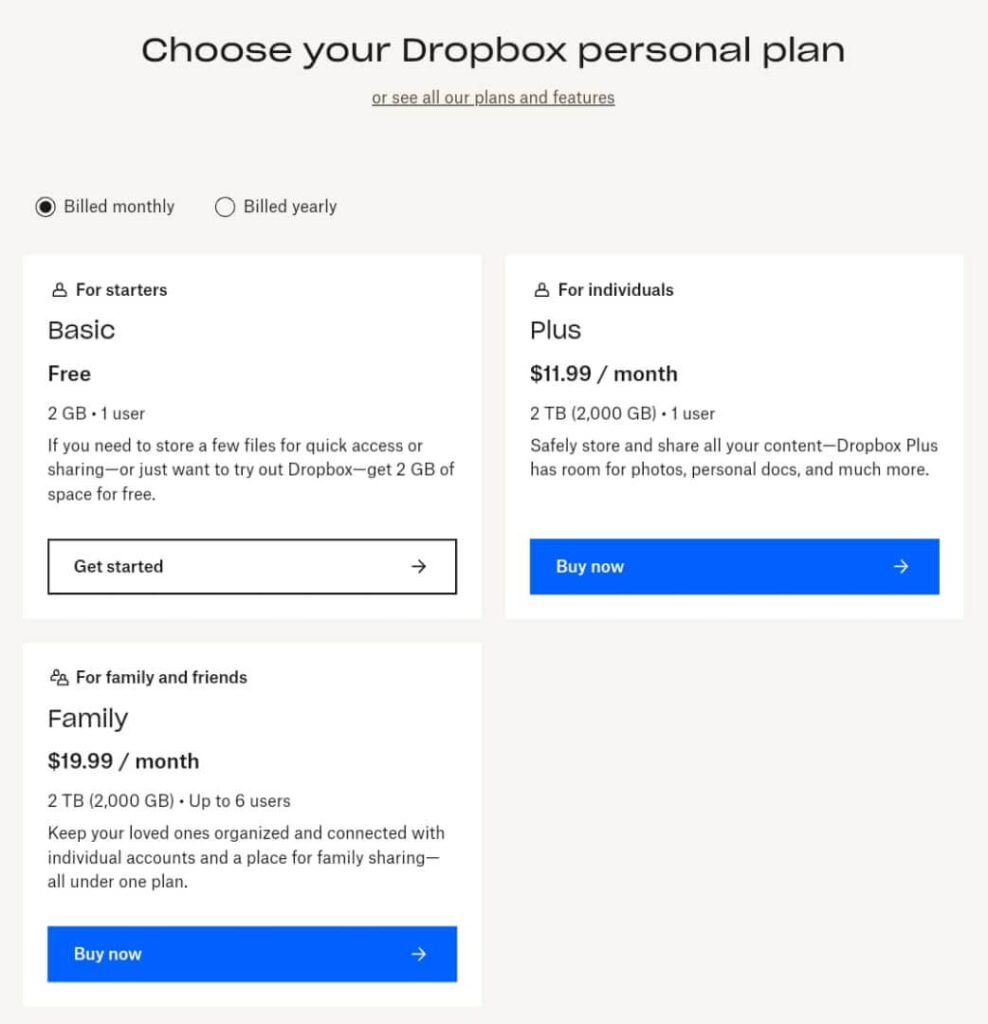What is Freemium?
The term “freemium” is a combination of the words “free” and “premium,” indicating that the business model offers both free and paid versions of its product or service. It’s a pricing strategy popular with the digital and software industries.
In this approach, a company provides a basic version of its product or service to users at no cost. This free version often comes with limited features or functionality, but it allows users to experience the product and understand its value proposition. The goal here is to attract a large user base and create brand awareness through the free offering.
At the same time, the company offers a premium or paid version of the product with additional features, enhanced capabilities, or exclusive content. Users who require more advanced features or a higher level of service can choose to upgrade to the premium version by paying a fee.
This way, the company monetizes its user base, generating revenue from those who are willing to pay for the extra value provided by the premium offering.
The freemium business model capitalizes on the idea that a significant portion of free users will eventually convert to paying customers if they find enough value in the product or service.
MORE: What is Prestige Pricing?

Freemium Vs. Free Trials
Freemiums and free trials may seem similar because they involve offers, but there are clear differences between the two concepts. Here are four key differences between freemium and free trials:
| Differences | Freemium | Free Trials |
|---|---|---|
| Access Period | Users can access the free version for an indefinite period, with the option to upgrade to the premium version at any time. | Users have temporary full access to the product for a predetermined duration, usually 7, 14, or 30 days. |
| Feature Limitations | The free version has restricted functionality or limited access to certain advanced features, encouraging users to opt for the premium version. | Users can enjoy the complete set of features during the trial period, giving them a comprehensive understanding of the product’s capabilities. |
| Conversion Incentives | Encourages users to explore the product’s basic functionality and become familiar with it before deciding to upgrade for additional benefits. | Aims to entice users by allowing them to fully experience the product’s value during the trial, increasing the likelihood of conversion into paying customers. |
| Retention Strategy | Focuses on retaining a larger user base by providing a perpetual free offering while converting a portion of users into paying customers over time. | The intention here is to give users a taste of the product’s value and convince them to become paying customers after experiencing its benefits during the trial period. |
MORE: What is Cost Plus Pricing?
Pros and Cons of a Freemium Business Model
The freemium business model offers several advantages for companies. At the same time, there are some drawbacks that you may want to consider.
| Pros | Cons |
|---|---|
| Providing a free version of the product helps the company to attract a larger number of users who might not be willing to pay upfront. | Converting free users to paying customers can be difficult, and the conversion rates may be relatively low. |
| The free version acts as a marketing tool. Satisfied free users may share their positive experiences with others, leading to potential organic growth for the company. | Some users may associate free products with lower quality or reliability, potentially affecting the brand’s overall perception. |
| The freemium model focuses on building long-term relationships with customers. Even though a small percentage of users may convert to paid customers, their recurring revenue over time can be substantial. | Offering a free version can be financially challenging, especially if the costs of maintaining the free service outweigh the revenue generated from the premium upgrades or other monetization methods. |
| Freemium models allow companies to have multiple revenue streams. While some users opt for the premium version, others may generate revenue through ads or other monetization strategies. | Determining the most effective and fair monetization strategy (e.g., pricing tiers, advertising, or microtransactions) can be complex and requires careful consideration. |
Freemium Examples
Now, let’s examine some freemium business model examples to understand how the strategy works in the real world.
1. Canva
Canva offers a basic version of its graphic design platform for free, allowing users to create various designs with limited features and assets. Its premium subscription, known as Canva Pro, unlocks additional features such as a larger library of assets, brand kit management, advanced design elements, team collaboration, and more.

More than 100 million people use Canva each month. Unlike advanced graphic design software that targets only designers, Canva goes after everyone, allowing people with little or no design skills to create simple designs with its drag-and-drop components into their designs.
2. Dropbox
Dropbox is a cloud-based file storage service that allows users to store and share files, documents, photos, and videos across different devices and platforms. The main difference between the free and premium versions of this software is that the free version offers a limited storage space of 2GB, while the premium offers up to 3TB for professional accounts or 5TB for Dropbox Business.

Dropbox was founded in 2007, and up to 2011, only 4 percent of its users were paying customers. Nevertheless, the freemium business model was instrumental to its growth. Coupled with a referral program, Dropbox was able to grow its user base by 3900 percent over 15 months. Fast forward to 2020, Dropbox had over 700 million registered users, 17.14 million paying customers, and $1.91 billion in annual revenue.
3. Zoom
Zoom gained widespread popularity, particularly during the COVID-19 pandemic, as it became an essential tool for remote work, online education, and social interactions. The free version allows users to host group meetings with a limited duration of 40 minutes for group meetings with three or more participants. And the number of participants cannot exceed 100.

Paid users can host meetings for up to 30 hours with 300 (business plan) or 500 participants (enterprise plan). Additional perks for paid plans include integrations with third-party apps, reporting and analytics, and cloud recording features, which enable users to store recorded meetings directly on Zoom’s cloud servers. Read our Zoom pricing review.
Zoom is now the most popular video conferencing software in the world with over 943 million unique visits in March 2023.
4. HubSpot CRM
With the free version of HubSpot CRM, you can easily automate repetitive tasks, create targeted campaigns for leads and customers, and manage all your business contacts in one central location. But the limited user access can be a setback if you work with large team members. Moreover, you may have limited customization options and integrations with third-party tools.
In his interview with Chargebee, Kieran Flanagan, ex-SVP of Marketing at HubSpot highlighted some key drivers behind the brand’s freemium business model:
“…people wanted to feel in control of the purchase path and that means actually consuming the stuff for themselves. Extracting some value to see if it’s right for them. And, then, deciding to pay you money once they’ve made that decision“
He also mentioned that HubSpot adopted the freemium business model to differentiate itself in the competitive CRM software market.
How to Convert Freemium Users to Paying Customers
Here are some excellent tips and strategies freemium businesses use to increase conversions and generate more revenue:
1. Set the Right Feature Limits for Free Users
When offering a freemium model, it’s essential to strike a balance between providing valuable features for free and enticing users to upgrade for more advanced functionalities. Ensure that the free version offers enough value to attract users, but keep some essential features exclusive to the paid version to encourage conversions.
2. Segment your Freemium User Base
Understand your freemium users better by segmenting them based on their usage patterns, demographics, preferences, or engagement levels. This segmentation allows you to target different groups with personalized messages and offers, increasing the chances of converting them into paying customers.
3. Use In-app Prompts to Remind Users to Upgrade
Implement unobtrusive in-app prompts strategically throughout the user journey. These prompts can appear at appropriate times, such as after users have used a particular premium feature or when they attempt to access locked features. Customize the messages to highlight the benefits of upgrading to a premium plan.
4. Offer Discounts and Promotions
Periodically run time-limited promotions or offer discounts to incentivize free users to upgrade. You can use seasonal events, holidays, or product milestones as opportunities to introduce special offers. Communicate the limited nature of these promotions to create a sense of urgency and encourage immediate action.
5. Use Tiered Pricing
Create different tiers of paid plans with varying levels of features, benefits, and pricing. Clearly outline the differences between each tier so that free users can easily compare and understand the added value of each plan. This approach allows users to choose the tier that aligns best with their specific needs and budget, increasing the likelihood of conversion.
MORE: What is a tiered pricing strategy?.
6. Share Customers’ Success Stories
Showcase real-life success stories of paying customers who have achieved significant results using your product. These stories can be in the form of case studies, testimonials, or user-generated content.
Highlight the specific challenges they faced and how your product helped them overcome those challenges. This social proof can build trust and demonstrate the value of your product to potential paying users
MORE: What is value-based pricing?
7. Provide Educational Content
Offer free educational resources that showcase the full potential of your product. This content can include tutorials, how-to guides, webinars, or blog posts that demonstrate various use cases and advanced features. Onboarding customers properly empower them to make informed decisions about upgrading to paid plans.
8. Implement Referral Programs
Create a referral program that encourages free users to refer your product to their friends, colleagues, or social network. Remember, this is the same strategy that helped Dropbox to achieve insane growth in a short period.
Here’s how it works: offer attractive incentives to users who refer others to your product. The incentive could be in the form of discounts, extended free trials, or exclusive premium features. Then, provide rewards for new users who sign up through referrals.
It could be a special discount on their first paid plan or additional free trial days. This way, the referral program is mutually beneficial for the referrer and the referred user.
MORE: What Is a Bundle Pricing?
Key Takeaways
The freemium business model presents both challenges and opportunities. While it requires patience and perseverance during the initial stages, the long-term benefits can be rewarding.
The gradual process of acquiring a substantial user base and converting free users to paying customers demands careful planning and continuous improvement. You will need to educate your users and refine your offerings based on feedback to achieve success.
Check out SaaSGenius to uncover more business tips, software solutions, and hacks that will not only enable you to implement your pricing strategy right, but also boost your business performance.












